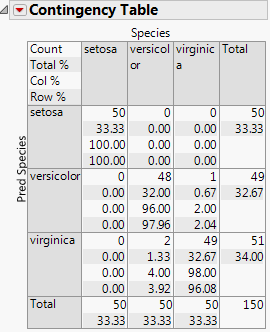Example of the Save Discrim Option
The Save Discrim Option in the Manova personality of the Fit Model platform enables you to create columns that can be used in other JMP platforms to summarize the discriminant analysis with reports and graphs. In this example, there are k = 3 levels of the effect variable and four measures on each sample.
1. Select Help > Sample Data Folder and open Iris.jmp.
2. Select Analyze > Fit Model.
3. Select Sepal length, Sepal width, Petal length, and Petal width and click Y.
4. Select Species and click Add.
5. Next to Personality, select Manova.
6. Click Run.
7. Click the Manova Fit red triangle and select Save Discrim.
The following columns are added to the Iris.jmp sample data table:
SqDist[0]
Quadratic form needed in the Mahalanobis distance calculations.
SqDist[setosa]
Mahalanobis distance of the observation from the Setosa centroid.
SqDist[versicolor]
Mahalanobis distance of the observation from the Versicolor centroid.
SqDist[virginica]
Mahalanobis distance of the observation from the Virginica centroid.
Prob[0]
Sum of the negative exponentials of the Mahalanobis distances, used below.
Prob[setosa]
Probability of being in the Setosa category.
Prob[versicolor]
Probability of being in the Versicolor category.
Prob[virginica]
Probability of being in the Virginica category.
Pred Species
Species that is most likely from the probabilities.
Now you can use the new columns in the data table with other JMP platforms to summarize the discriminant analysis with reports and graphs. For example:
1. From the updated Iris.jmp data table (that contains the new columns) select Analyze > Fit Y by X.
2. Select Species and click Y, Response.
3. Select Pred Species and click X, Factor.
4. Click OK.
The Contingency Table summarizes the discriminant classifications. Three misclassifications are identified.
Figure 10.9 Contingency Table of Predicted and Actual Species
